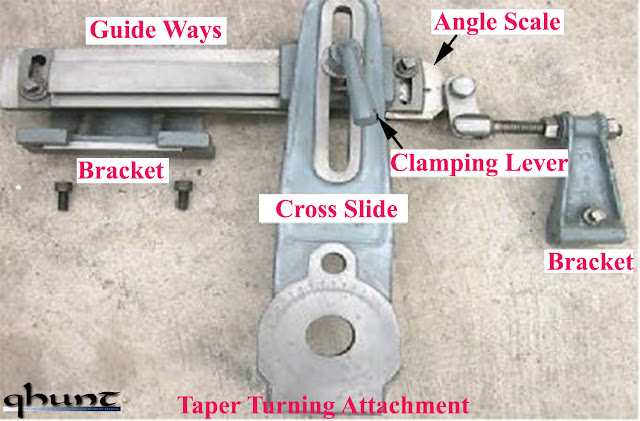Lathe machines are generally used
for machining cylindrical nature of general work. In addition, it is possible
to provide special enhancement to the capability of the machine. Attachments
are used on centre lathe to increase production and efficiency and widen its
scope of use for such works which are normally not carried out on this machine.
Types of attachments
The commonly used attachments
are:
(a) Taper turning attachment
(b) Ball turning attachment
(c) Thread Chasing Dial
(d) Eccentric turning attachment
(e) Grinding attachment
Taper Turning Attachment
The principle of turning taper by
a taper attachment is to guide the tool in a straight path set at an angle to
the axis of rotation of the workpiece. The
work is being revolved between centres or by a chuck aligned to the lathe axis.
A taper turning attachment consists essentially of a
bracket or frame which is attached to the rear end of the lathe bed and
supports a guide bar pivoted at the centre. The bar having graduations in
degrees may be swiveled on either side of the zero graduation and is set at the
desired angle, with the lathe axis.
When the taper turning attachment
is used, the cross slide is first made free from the lead screw by removing the
binder screw. The rear end of the cross slide is then tightened with the guide
block by means of a bolt. When the longitudinal feed is engaged, the tool
mounted on the cross slide will follow the angular path, as the guide block
will slide on the guide bar set at an angle to the lathe axis. The required
depth of cut is given by the compound slide which is placed at right angles to
the lathe axis. The guide bar must be set at half angle and the taper on the
work must be converted in degrees. The maximum angle angle through which the
guide bar may be swiveled is 100 to 120 on either side of the centre line.
If the large diameters (D), small
diameter (d) and the length of the taper (L) are given, the angle of swiveling
the guide bar can be determined from equation:
Advantages - The following are the advantages of the taper turning
attachment:
(a) The alignment of live and
dead centres being not disturbed, both straight and taper turning may be
performed on the work-piece in one setting without much loss of time.
(b) Once the taper is set, any
length of a piece of work may be turned taper within its limits.
(c) Accurate taper on a large
number of work pieces may be turned.
(d) Internal tapers can be turned
with ease.
Ball Turning Attachment
It is an attachment mounted on
the cross slide after removing the compound rest. It is used for turning
segment and sphere. It is in two halves, lower half and upper half. Lower half
is fixed with the cross slide and upper half can be rotated with the help of a
lever. There is a tool block on the top of the upper half in which provision is
made to hold the tool firmly. Tool block can be moved towards the centre or
away from the centre to facilitate the turning of different diameter
balls.
Thread Chasing Dial
When cutting threads one has to
take several cuts and for this the tool has to be withdrawn from the thread on
completion of each cut and again brought to starting position. If the tool does
not follow the path, the threads will be spoiled. So to achieve this, thread
chasing dial is fitted on the lathe. The chasing dial overcomes the difficulty
of catching the threads at correct start. It consists of graduated dial that is
connected to a
Worm wheel - The worm is in mesh with the lead screw, so that if
the saddle is stationary, the lead screw acts as a worm and rotates the chasing
dial. When the half nut is engaged, the tool starts travelling but the dial
remains stationary with one of the graduations opposite to the arrow. When the
cut is completed the saddle is returned to the starting point. When the nut is
disengaged and the dial remains rotating as soon as the graduated line comes
opposite to the arrow, the half nut can be engaged and the tool will follow its
original cut.
Eccentric Turning Attachment
It refers to the turning of
certain diameters at different lengths on the same shaft or jobs whose axis is
not falling in line with the main axis. A crank shaft of an engine is the
example of such job. This type of attachment is equipped with the provision of
shifting the centres of the work away from the lathe spindle axis. An accurate
marking and truing is of prime important in the sequence of operation of jobs
of this nature.
Grinding Attachment
It is also called tool post grinder. It is
mounted on the compound rest in place of tool post. This attachment consists of
a base plate, grinding wheel and a motor. The job is held in a chuck or between
centres. It is extensively used for grinding lathe centres in position. With
this attachment many other grinding operations can be performed on the lathe.
It is a useful attachment, which can be mounted on any lathe. It can grind
hardened work and ensures a fine finish. Internal grinding can also be done
with this grinder.










No comments